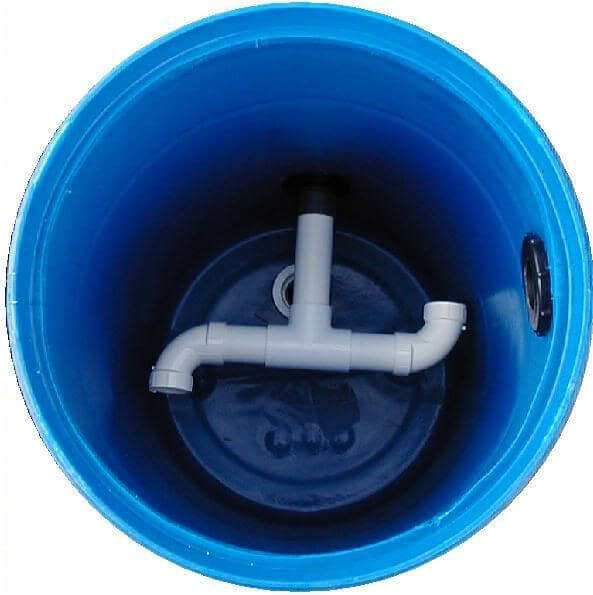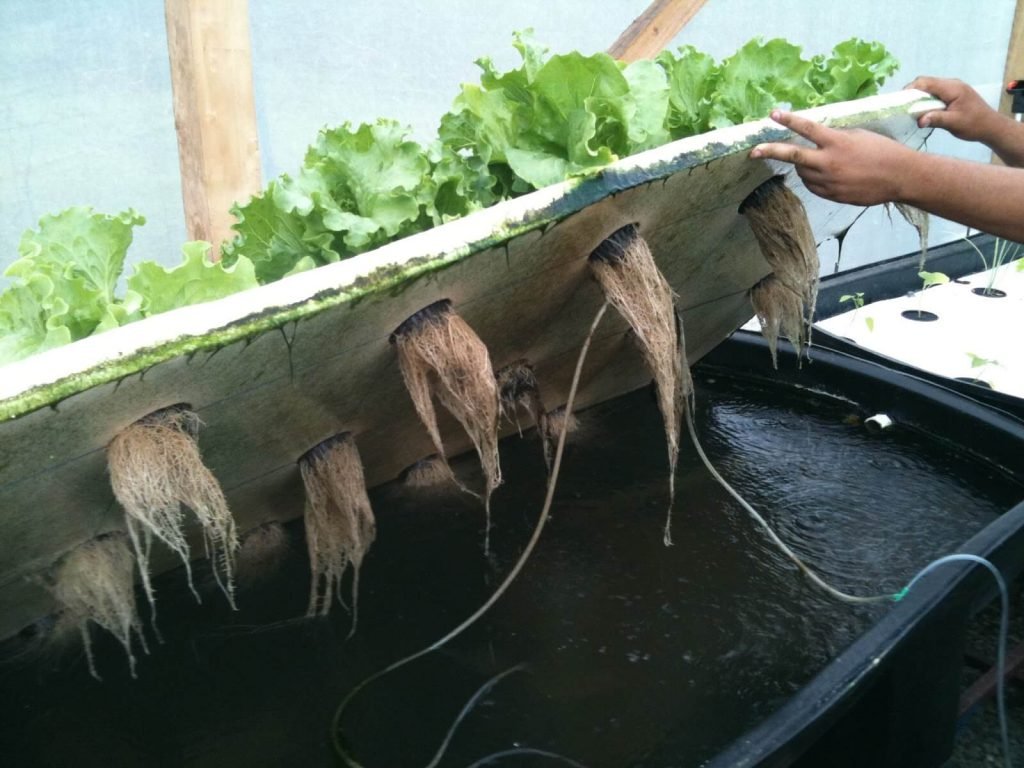Swirl Filter for Aquaponics
A swirl filter also called an aquaponics solids filter, is often used in an aquaponics system to free the water of fish waste that is not easily filterable otherwise. It is basically a tool to help maintain water clarity so that your fish can survive and thrive. A swirl filter actually spins the water and in this process, all solids are removed.
What Is a Swirl Filter and How Does It Work?
The swirl filter mechanism is all about calming the whirlpool of the water. For this purpose, you will need a big barrel.
The pipe that brings water from the fish tank into the barrel is purposely bent. It is shaped so that the water that comes through can be swirled at the bottom. When the water is slowed down, the particles heavier than water start settling at the bottom of the barrel. The excess fish solids can then be drained off from the bottom.

The basic principle on which this swirl filter for aquaponics works involves the idea of collecting all solid waste on the base of the filter. This is put into action by moving water from the fish tank with the help of a pipe, which has such a special design that the wastewater starts moving in a spiral at the bottom. The centrifugal force created by this action brings all the solid waste together and prevents them from going back to the growbed.
Why Should You Use a Swirl Filter?
The water needs to be free from the suspended particles formed by floating debris, food particles and fish waste before it returns to the fish tank. If you want your operation to run smoothly, you will need some type of solids waste removal.
Furthermore, this method of filtration prevents the plant roots from getting clogged in an NFT aquaponics system, hence facilitating oxygen absorption and the intake of dissolved nutrients.
It is necessary to install a filter system, especially a swirl filter, in an aquaponics system, just like it is a basic requirement in a normal aquarium. You may not think this is important since it is commonly perceived that plants can act as a filter in an aquaponics system, so the system won’t need a dedicated filter.
There is no actual need for a swirl filter in a conventional DIY aquaponics system. The cleaning is done by the worms in the grow bed that oxidizes the organic matter in the fish waste and free the basic system from a burden that is beyond its handling capacity.
However, in order to further reduce the solid waste that is in circulation in the aquaponics system according to the kind of fish present, using a swirl filter is not a bad idea. In case you are seeing cloudy and hazy water more than usual, it is definitely time to make an addition into your aquaponics system with a swirl filter.
Furthermore, this solids filter can become a way to extend your aquaponics system to a greater area, such as wicking beds or plant beds. The solid waste can even be mineralized through aeration to serve as a natural fertilizer for your soil garden.
You should also know that the mineralized water is extremely rich in nutrients. Hence, if it is drawn back into the aquaponics system, it can prove to be a very cost-effective way to reduce the expenditure on nutrients in the grow bed.
An alternative to using a swirl filter would be using more than one grow bed. However, this option would eventually require more space, which might not be an option for everyone. Therefore, if you have limited space, you can install a swirl filter to accommodate more fish with the same efficiency as that of multiple grow beds.
bottom line:
- In a small DIY system, you don’t need a swirl filter or solids filter. Your worms in the growbed will take care of the solids.
- If you don’t use a swirl filter but have a growbed setup with worms and you still see solids it’s a good idea to get an extra growbed or swirl filter.
- If you go commercial or have a big setup without growbeds you need some sort of solids filtration like a swirl filter.
DIY 55-Gallon Barrel Swirl Filter
Here is good news for you all! Those of you who are planning to buy a swirl filter for their backyard aquaculture or aquaponics system but are on a budget don’t need to worry, as there is a very easy, cost-effective and quick method to make one yourself.
Before we dive into creating your own swirl filter, we should clear up one common misconception. As settling filters and swirl filters are quite alike in their designs, users usually consider them to be the same thing. However, this is not the case. Settling filters are larger with a rotational velocity comparatively slower than that of swirl filters. With very minor differences between them, the determining factor of the effectiveness of each filter is the design on which they are built.
While making a simple swirl filter on your own, factors including retention time (the duration for which a measured volume of water remains inside the filter) should be set very carefully. For achieving the optimum filtration by the swirl filter, keep the retention time very short. It should be no longer than a few minutes long.

Build your own swirl filter by following the simple instructions below:
- Take a big drum with a volume of 55 gallons (200 liters).
- Mark two holes on adjacent sides, but one should be a little higher. Drill these two holes with one as the inlet and the higher one as the outlet that will be connected to the grow bed or biofilter. Do not forget to use an adaptor so that there is no chance of leakage in the pipe connection and the connection is watertight.
- For the exit of the solid waste, drill a hole at the lowest point of the barrel. This can include a tiny PVC line of half an inch, and you can connect a valve to it in order to regulate the flow.
That is all! It is this simple to make your own DIY swirled filter to make your aquaponics system as efficient as possible at minimum cost.
DIY 5-Gallon Bucket Filter
This bucket filter follows a similar design and idea as the 55-gallon barrel above, but it has a smaller size. This is how you can make it without anyone’s help:
- Take a 5-gallon bucket.
- Take two differently sized adaptors, one of 3 inches and the other of 1 inch. We will be using the smaller adaptor for marking the exit drain on the base of the bucket, and the larger one to mark the inlet that will be entering the grow bed.
- Drill the holes marked in the previous step.
- Do not forget to use an adaptor so that there is no chance of leakage in the pipe connection and the connection is watertight. You will be familiar with the next steps if you have already built the 55-gallon filter described above.
- For the exit of the solid waste, drill a hole at the lowest point of the barrel. This can include a tiny PVC line of half an inch, and you can connect a valve to it in order to regulate the flow.
See this youtube video for the instructions:
Where Can You Buy a Swirl Filter?
There are two ways to get yourself a swirl filter: by making your own filter or by buying one from a nearby pond store. If you are going for the second method, know your budget and compare rates from different stores so that you can find the best filter in your budget. This should be done without making any compromises on the quality of the product.
Use online maps to locate nearby pond stores. A bit of advice is to first read reviews on swirl filters from different shops before buying one.
Do not go for a filter with a lot of additional functionalities if your aquaponics system does not require them. Stay focused on your requirement and buy accordingly. Make use of the internet wisely and search for a while until you come across the product of your choice with the best price.
There are many online forums discussing the pros and cons of many different products including swirl filters. Make sure you become an active member of such a forum and have conversations with fellow members to get an in-depth idea of which swirl filter to buy and from where.
You might even meet experts in fish farming and aquaculturists over such forums. Get advice from them about the suitable features you should look for and how to find the best product for your requirements.
Conclusion
By using filtration techniques like swirl filters, the waste in your aquaponics system can be easily removed. This filtration technique works on big particles that have a higher density than water and, therefore, easily settle. There are a number of other feasible ways as well that can be followed to reduce the overall waste in the system. You just have to find the one that works the best for your particular situation.
You can also try to reduce the production of waste in the first place. Never overfeed your fish, as overfeeding will not only become waste in the tank but also clog the growbed, DWC, or more importantly the NFT channels.
Furthermore, do not go for low-quality fish food just to save a few pennies, as it would eventually end up becoming waste in your system.
Also, do not overpopulate your system; make a plan based on the future size of the fully-grown fish to determine their quantity. The higher the number of fish, the more waste is going to be produced, which is eventually going to harm your plants and the overall system.
In case you are doubtful about the quality of the feed or the filters you are using, closely observe the roots of the plants. If their color has turned to brown or grey or they feel like slime, it is a clear indication of the presence of debris beyond the safe limit. Hence, you will need to buy a better quality of feed and install a swirl filter.

In case you want to cut down on the maintenance cost of your aquaponics system, it is highly recommended to install a swirl filter due to its efficiency.
Read more:


